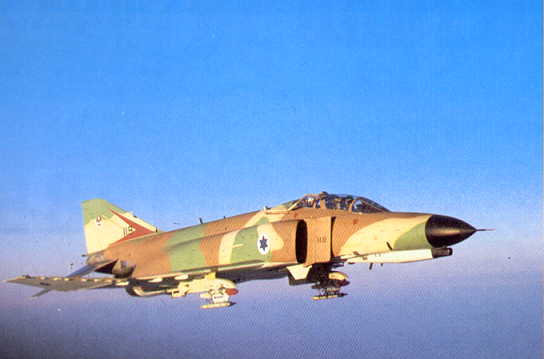
Egyptian Mig-21
Egypt had launched the War of Attrition shortly after the end of the Six Days War (1967), hoping to force Israel into
concessions the Arabs had failed to extract on the battlefield or in the international arena. Egyptian intensions were for
a limited conflict, where Egypt's superior artillery force would barrage Israeli forces on the Suez Canal, inflicting
enough casualties to move Israel towards giving up some of the land it had captured during the Six Days War. On the
ground however, things went rather differently. Besides Egypt's failure to inflict the heavy casualties it had relied upon,
Israel had no intension to sit idly by, waiting for an end to the Egyptian attacks. Israel retaliated by means of its own,
using its army, navy, and most of all its air force, to attack and strike at Egypt, sending a clear indication that it will
defend itself against these attacks. By 1970 Israeli superiority was apparent, with the IAF operating almost freely above
Egyptian terriory, the local air defences unable to stop the IAF from attacking ground targets or flying air-to-air missions.
This was not lost upon Egypt's main sponsor, the USSR, which had armed Egypt with the best Soviet arms it had to offer.
But these were not enough and when Egypt's president Nazer asked for further assistance, the Soviet Union responded by
actually sending Russian pilots to help in the defence of Egypt's airspace. February 1970 saw the arrival of these Russian
pilots along with 80 new Mig-21s, a large number of SAM batteries and other weapons for the Egyptian arsenal.

At first the Russian pilots were confined to defending their own air bases as well as to the defence of Cairo's
airspace. But as time passed Soviet assistance to the Egyptian anti aircraft forces begun to bear fruit and begun to
hamper IAF operations, disrupting IAF deep penetration strikes which had been carried out rather freely before. This
success pushed the Russians into further envolvement and they begun taking over missions previously carried out
by the Egyptian Air Force, coming ever closer and closer to actively confronting the IAF.
Russian pilots began approaching IAF aircraft during April 1970 but Israeli pilots had orders not to engage these
aircraft, and broke off whenever Russian Migs appeared, on occurances such as on the 13th, 18th and 29th.
Although no confrontation took place, these events were widely reported in the international media. The Israeli minister
of defence offered to limit IAF operations to the Suez Canal zone, if the Russians were to remain over Cairo and the
heartland of Egypt, and for two months no Russian presence was detected in the Canal zone. On June 25th however,
this "cease-fire" was broken when an Israeli Skyhawk, on an attack sortie against Egyptian forces on the Canal, was
pursued by a pair of Mig-21s into the Sinai. One of the Migs launched an air-to-air missile against the Skyhawk,
damaging it and forcing it to land in a nearby air base. This aggresive act on the part of the Russians and their intrusion
into Israeli air space canceled any Israeli reservations about confronting the USSR. A plan began forming for a purely
Soviet-Israeli confrontation where the Russians were to be taught that they are out of their league. Set to take place a
third of the way between the city of Suez and Cairo, 12 of Israel's best fighter pilots, together credited with 59 enemy
aircraft kills, were recruited for this specific mission.

On thurday, April 30th, a pair of F-4 Phantoms attacked an Egyptian radar station on the west bank of the Canal,
escorted by 4 Mirage IIIs. No Russian response was sighted and the 4 Mirages begun penetrating deeper into Egypt.
12 minutes after the intial penetration 8 Russian Mig-21s were scrambled against the IAF fighters and first contact
was made at 14:20. Coming from the east, the Mirages lured the Migs westward towards Cairo, when another quartet
of Israeli Mirages appeared behind the Russians. With the confrontation clearly about to take place, every available
Russian fighter was launched againt the Mirages and within seconds another 12 Migs were in the air. The air battle
began with 8 Mirages facing 20 Mig-21s, but soon 4 Israeli Phantoms which had entered the area below radar coverage
appeared from below and joined in the fight. Led by Avihu-Ben-Nun, Israel's first Phantom squadron commander (and
IAF chief of staff during the Gulf War of 1991), the new addition to the battle caused the Russians to launch yet another
4 Migs into the air, bringing the total number of aircraft participating in the dog fight to 36 aircraft.
The first Russian loss was shot down by the lead of the first Mirage III quartet, soon followed by an AIM-7 Sparrow
kill from Avihu-Ben-Nun's aircraft, and a cannon kill by another Mirage III. After a fourth Mig was shot down by an F-4,
the Russian pilots began breaking off. The Israeli fighters started giving chase but were ordered to return to Israel,
with a desire by the IAF high command not to see any aircraft loss on the part of the IAF. Details of the dogfight were
kept a secret, even from the aircraft ground crews which painted the Egyptian air force emblem as kill markings on the
aircraft. Only after the story was published two months later in the British "Daily Express" were these markings changed
to the Soviet air force's Red Star. The story revealed that besides the 4 known kills, another damaged aircraft had
crashed approaching its air base, bringing the final result to 5:0 in favour of the IAF. Three Russian pilots parachuted to
safety and two were killed. The source of the media report was apparently Egyptian, spurred by Russian arrogance and
claims of Egyptian incompetence in earlier dealings with the Israeli Air Force.

 back to the IDF/AF page
back to the IDF/AF page